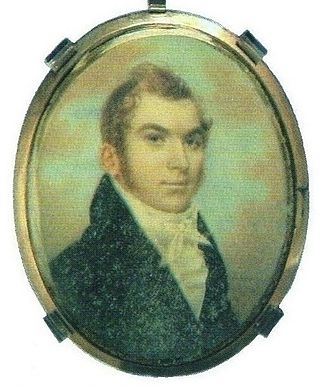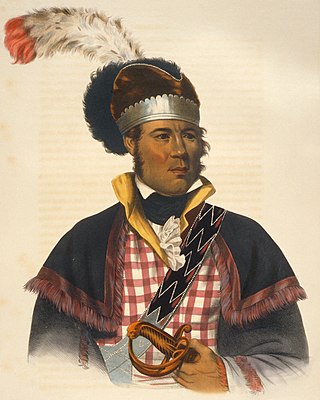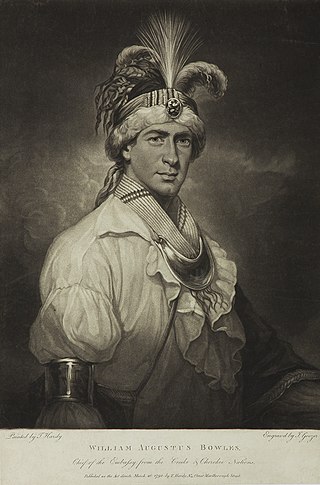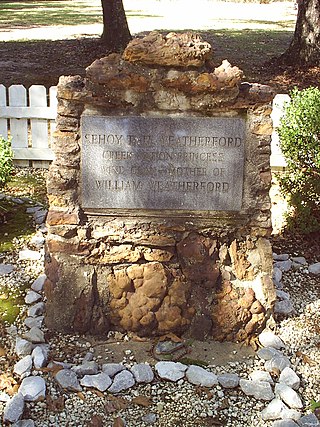Related Research Articles

The Muscogee, also known as the Mvskoke, Muscogee Creek or just Creek, and the Muscogee Creek Confederacy, are a group of related Indigenous peoples of the Southeastern Woodlands in the United States. Their historical homelands are in what now comprises southern Tennessee, much of Alabama, western Georgia and parts of northern Florida.

The Creek War was a regional conflict between opposing Native American factions, European powers, and the United States during the early 19th century. The Creek War began as a conflict within the tribes of the Muscogee, but the United States quickly became involved. British traders and Spanish colonial officials in Florida supplied the Red Sticks with weapons and equipment due to their shared interest in preventing the expansion of the United States into regions under their control.

Alexander McGillivray, also known as Hoboi-Hili-Miko, was a Muscogee (Creek) leader. The son of a Muscogee mother and a Scottish father, he was literate and educated, and understood the "white" European world and merchandise trading well. These gave him prestige, especially with European Americans, who were glad to finally find a Creek leader they could talk to and deal with. He used his role as link between the two worlds to his advantage, not always fairly, and became the richest Creek of his time.

William Weatherford, also known after his death as Red Eagle, was a Creek chief of the Upper Creek towns who led many of the Red Sticks actions in the Creek War (1813–1814) against Lower Creek towns and against allied forces of the United States.
Lachlan McGillivray was a prosperous fur trader and planter in colonial Georgia with interests that extended from Savannah to what is now central Alabama. He was the father of Alexander McGillivray and the great-uncle of William McIntosh and William Weatherford, three of the most powerful and historically important Native American chiefs among the Creek of the Southeast.

William McIntosh, also commonly known as Tustunnuggee Hutke, was one of the most prominent chiefs of the Creek Nation between the turn of the 19th-century and his execution in 1825. He was a chief of Coweta town and commander of a mounted police force. He became a large-scale planter, built and managed a successful inn, and operated a commercial ferry business.

The Coushatta are a Muskogean-speaking Native American people now living primarily in the U.S. states of Louisiana, Oklahoma, and Texas.

William Augustus Bowles was an American-born military officer and adventurer. Born in Frederick County, Maryland, Bowles was commissioned into the Maryland Loyalists Battalion at the rank of ensign, seeing action during the American Revolutionary War, including the 1781 siege of Pensacola. He subsequently established an alliance with the Muscogee and founded the State of Muskogee. In 1803, Bowles was betrayed and handed over to the Spanish, who imprisoned him in Morro Castle, where he died two years later.
Hitchiti was a tribal town in what is now the Southeast United States. It was one of several towns whose people spoke the Hitchiti language. It was first known as part of the Apalachicola Province, an association of tribal towns along the Chattahoochee River. Shortly after 1690, the towns of Apalachicola Province moved to the central part of present-day Georgia, with Hitchiti joining most of those towns along Ochese Creek. In 1715, most of the towns on Ochese Creek, including Hitchiti, moved back to the Chattahoochee River, where the town remained until its people were forced to move to Indian Territory as part of the Trail of Tears.

Okfuskee are a Muscogee tribe. Alternative spellings include the traditional Mvskoke spelling "Akfvske", referring to the tribal town in Alabama, and the comparable spelling Oakfuskee. They formed part of the former Creek (Muscogee) Confederacy in Alabama, prior to their removal during the 1830s to the Indian Territory. Okfuskee County, Oklahoma is named for a settlement where members of the tribe formerly lived.
Red Shoes was a Muskogean leader of the Tuskegee people in the 18th century. He primarily lived in modern Alabama near Tuskegee at the forks of the Alabama River, but his influence extended well into modern Mississippi.

The Muscogee Nation, or Muscogee (Creek) Nation, is a federally recognized Native American tribe based in the U.S. state of Oklahoma. The nation descends from the historic Muscogee Confederacy, a large group of indigenous peoples of the Southeastern Woodlands. Official languages include Muscogee, Yuchi, Natchez, Alabama, and Koasati, with Muscogee retaining the largest number of speakers. They commonly refer to themselves as Este Mvskokvlke. Historically, they were often referred to by European Americans as one of the Five Civilized Tribes of the American Southeast.

Fort Toulouse and Fort Jackson are two forts that shared the same site at the fork of the Coosa River and the Tallapoosa River, near Wetumpka, Alabama.
The Alabama–Quassarte Tribal Town is both a federally recognized Native American tribe and a traditional township of Muskogean-speaking Alabama and Coushatta peoples. Their traditional languages include Alabama, Koasati, and Mvskoke. As of 2014, the tribe includes 369 enrolled members, who live within the state of Oklahoma as well as Texas, Louisiana, and Arizona.
Samuel Checote (1819–1884) (Muscogee) was a political leader, military veteran, and a Methodist preacher in the Creek Nation, Indian Territory. He served two terms as the first principal chief of the tribe to be elected under their new constitution created after the American Civil War. He had to deal with continuing tensions among his people, as traditionalists opposed assimilation to European-American ways.

Fort Bainbridge was an earthen fort located along the Federal Road on what is today the county line between Macon and Russell counties in Alabama. Fort Bainbridge was located twenty-five miles west of Fort Mitchell.

Fort Hull was an earthen fort built in present-day Macon County, Alabama in 1814 during the Creek War. After the start of hostilities, the United States decided to mount an attack on Creek territory from three directions. The column advancing west from Georgia built Fort Mitchell and then clashed with the Creeks. After a pause in operations, the column from Georgia continued its march and built Fort Hull. The fort was used as a supply point and was soon abandoned after the end of the Creek War.
Sophia Durant was a Koasati Native American plantation owner, who served as the speaker, interpreter, and translator for her brother, Alexander McGillivray, a leader in the Muscogee Confederacy.

Sehoy III, also called Sehoy Weatherford was a Muscogee Creek trader who was part of the Sehoy matrilineage. Through her two marriages to white traders she was the mother of sons who were involved in the Creek War and the Red Sticks.

Sehoy II or Sehoy Marchand was a Muscogee Creek Wind Clan woman who was part of the Sehoy matrilineage. She and her family are known for their intermarriages with white traders, with the children inheriting their tribal identities from the mother's side.
References
Citations
- ↑ Waselkov 2006, pp. 35–36.
- 1 2 Wright 2007, pp. 184–85.
- 1 2 Waselkov 2006, p. 41.
- ↑ Wright 2022, pp. 42, 49.
- ↑ Braund 1991, pp. 615–16.
- ↑ Bartram 1955, p. 130.
- 1 2 Langley 2005, p. 237.
- ↑ Langley 2005, p. 232.
- ↑ Meserve 1938, p. 407.
- 1 2 3 Waselkov 2006, p. 280.
- ↑ Cashin 2002, pp. 73–74.
- ↑ Wright 2007, p. 185.
- ↑ Langley 2005, pp. 234, 236, 238–39.
- ↑ Mitchell 2002, p. 6.
- ↑ Waselkov 2006, p. 281.
- 1 2 3 4 Waselkov 2006, p. 36.
- 1 2 Wright 2007, p. 187.
- ↑ Waselkov 2006, pp. 36–37.
- ↑ Wright 2007, p. 186.
- ↑ Waselkov 2006, p. 39.
- ↑ Wright 2022, p. 49.
- ↑ Waselkov 2006, p. 42.
- ↑ Frank 2013.
- ↑ Blackmon 2014, p. 7.
- ↑ Wright 1967, p. 379.
- ↑ Langley 2005, p. 232; Frank 2013; Bartram 1955, p. 130; Wright 1967, p. 382.
- ↑ Pickett 1896, p. 419.
- ↑ Wells 1998, p. 83.
- ↑ Waselkov 2006, pp. 39–40.
- ↑ Saunt 2004, p. 253.
- ↑ Brown & Owens 1983, p. 96-97.
- ↑ Braund 2016.
- ↑ Appleton 2018.
- ↑ Meserve 1938, pp. 406–07.
- ↑ The Okmulgee Daily Times 1978, p. B12.
Bibliography
- Appleton, James Lamar (November 1, 2018). "David Moniac". The Encyclopedia of Alabama . Birmingham, Alabama: Alabama Humanities Foundation. Archived from the original on February 16, 2022. Retrieved August 30, 2022.
- Bartram, William (Fall 1955). "Extracts from the Travels of William Bartram". The Alabama Historical Quarterly. 17 (3). Montgomery, Alabama: Alabama State Department of Archives and History: 110–24. Retrieved August 26, 2022.
- Blackmon, Richard (2014). Stewart, Richard W. (ed.). The Creek War, 1813-1814. Washington, D.C.: Center of Military History, US Government Printing Office. ISBN 978-0-16-092542-9.
- Braund, Kathryn (January 27, 2016). "William Weatherford". The Encyclopedia of Alabama . Birmingham, Alabama: Alabama Humanities Foundation. Archived from the original on April 5, 2022. Retrieved August 30, 2022.
- Braund, Kathryn E. Holland (November 1991). "The Creek Indians, Blacks, and Slavery". The Journal of Southern History . 57 (4). Athens, Georgia: Southern Historical Association: 601–636. doi:10.2307/2210598. ISSN 0022-4642. JSTOR 2210598. OCLC 5278766921 . Retrieved 30 August 2022.
- Brown, Virginia Pounds; Owens, Laurella (1983). The World of the Southern Indians. Birmingham, Ala.: Beechwood Books. ISBN 978-0-912221-00-7.
- Cashin, Edward J. (January 2002). "Book Reviews: The McGillivray and McIntosh Traders on the Old Southwest Frontier, 1716–1815. By Amos J. Wright Jr. Montgomery: New South Books, 2000. pp. 347 (paper). ISBN 1-58838-006-8". Alabama Review . 55 (1). Tuscaloosa, Alabama: University of Alabama Press for the Alabama Historical Association: 73–75. ISSN 0002-4341. OCLC 5214355866. EBSCOhost 5570750.
- Frank, Andrew K. (June 27, 2013). "Alexander McGillivray". The Encyclopedia of Alabama . Birmingham, Alabama: Alabama Humanities Foundation. Archived from the original on March 19, 2022. Retrieved August 26, 2022.
- Langley, Linda (Spring 2005). "The Tribal Identity of Alexander McGillivray: A Review of the Historical and Ethnographic Data". Louisiana History. 46 (2). Baton Rouge, Louisiana: Louisiana Historical Association: 231–39. ISSN 0024-6816. JSTOR 4234109. OCLC 5544075024 . Retrieved August 24, 2022.
- Meserve, John Bartlett (December 1938). "Chief Samuel Checote, with Sketches of Chiefs Locher Harjo and Ward Coachman". The Chronicles of Oklahoma . 16 (4). Oklahoma City, Oklahoma: Oklahoma Historical Society: 401–409. ISSN 0009-6024.
- Mitchell, Garry (December 2, 2002). "Alabama Indian Tribe Seeks Federal Recognition". The Daily Oklahoman . Oklahoma City, Oklahoma. p. 6. Retrieved August 24, 2022– via Newspapers.com.
- Pickett, Albert James (1896). History of Alabama and Incidentally of Georgia and Mississippi, from the Earliest Period (Reprint ed.). Sheffield, Alabama: Robert C. Randolph. OCLC 1838277.
- Saunt, Claudio (2004). A New Order of Things: Property, Power, and the Transformation of the Creek Indians, 1733–1816 (Reprint ed.). Cambridge, Cambridgeshire: Cambridge University Press. doi:10.1017/CBO9780511511554. ISBN 978-0-511-51155-4. – via Cambridge Core (subscription required)
- Waselkov, Gregory A. (2006). A Conquering Spirit: Fort Mims and the Redstick War of 1813–1814. Tuscaloosa, Alabama: University of Alabama Press. ISBN 978-0-8173-5573-9.
- Wells, Mary Ann (1998). Searching for Red Eagle. Jackson, Mississippi: University Press of Mississippi. ISBN 978-1-61703-344-5.
- Wright, Amos J. (2007). The McGillivray and McIntosh Traders on the Old Southwest Frontier, 1716–1815 (Second ed.). Montgomery, Alabama: NewSouth Books. ISBN 978-1-60306-014-1.
- Wright, Miller Shores (February 2022). "Matrilineal Management: How Creek Women and Matrilineages Shaped Distinct Forms of Racialized Slavery in Creek Country at the Turn of the Nineteenth Century". The Journal of Southern History . 88 (1). Athens, Georgia: Southern Historical Association: 39–72. doi:10.1353/soh.2022.0001. ISSN 0022-4642. OCLC 9484472244. S2CID 246816557 . Retrieved August 24, 2022. – via Project MUSE (subscription required)
- Wright, J. Leitch Jr. (December 1967). "Creek-American Treaty of 1790: Alexander McGillivray and The Diplomacy of The Old Southwest". The Georgia Historical Quarterly . 51 (4). Savannah, Georgia: Georgia Historical Society: 379–400. ISSN 0016-8297. JSTOR 40578728. OCLC 5543046496 . Retrieved August 27, 2022.
- "History of Ward Coachman". The Okmulgee Daily Times. Okmulgee, Oklahoma. 17 September 1978. p. B12. Retrieved 30 August 2022– via Newspapers.com.